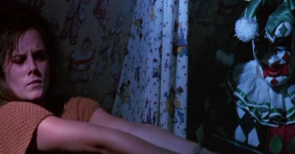
Whilst the early eighties saw a glut of summer camp (Friday the 13th, Madman, Sleepaway Camp) and event-themed slashers (Prom Night, Graduation Day, Happy Birthday to Me), sororities and fraternities had yet to play a prominent role in the genre. Bob Clark’s 1974 classic Black Christmas had made effective use of the location but since then slashers had mainly focused on either the wilderness or the suburbs. 1983’s The House on Sorority Row, which would mark the directorial debut of UCLA graduate Mark Rosman, would take the ‘prank gone wrong’ gimmick of Terror Train and The Burning and incorporate it into a Black Christmas-style environment. With no recognisable faces or gruesome effects, The House on Sorority Row, which was released as the slasher boom was slowly starting to run out of steam, would prove to be a modest hit, before finding its true audience on VHS.
Rosman’s first entry into filmmaking was as a protégé of cult director Brian De Palma, whose rise to prominence with Sisters and Carrie had made him one of the most respected artists in the industry. After gaining experience as his First Assistant Director on the 1980 comedy Home Movies, Rosman soon decided that the time had come to direct his own feature. Whilst his intentions were to make a thriller, Rosman was aware of the business that the likes of Halloween and Friday the 13th had done at the box office and realised that if he was to make a successful feature on a minimal budget then a slasher film would be the right move. After seeking advice from various different experts, Rosman penned his first screenplay and by the third draft it had become The House on Sorority Row.

The story opens in 1961 when Dorothy Slater (Lois Kelso Hunt) is giving birth to her first child. When the nurse is unable to deliver the baby in the traditional manner an emergency caesarean is performed. But when Mrs. Slater awakens she discovers that the child did not survive the procedure. Over twenty years later she is now the house mother at a sorority house know as Theta Pi, where she has gained a reputation as a nasty old woman. As the students prepare to pack after graduation, Katy Rose (Kathryn McNeil) is visited by her mother (Ruth Walsh), who has come to take her home. But one of her friends, Vicki (Eileen Davidson), informs Katy that the girls are going to throw one last party before they separate so she must remain at the house for the weekend. Mrs. Slater, meanwhile, has visited the hospital to meet with Dr. Nelson Beck (Christopher Lawrence), who tries to convince her to stay to overcome her long-term grief, but she insists that she must return back to the house.
Whilst Mrs. Slater is out of the house, Vicki has travelled to a barn with her boyfriend, Rick (Michael Sergio), to learn how to fire a fun. Later that evening, the friends –which also include Stevie (Ellen Dorsher), Morgan (Jodi Draigie), Liz (Janis Zido) Diane (Harley Kozak) and Jeanie (Robin Meloy) – are enjoying their last moments of freedom by getting drunk and telling each other amusing stories when suddenly Mrs. Slater bursts in and demands that they leave the following day. Soon after, Rick arrives and he and Vicki begin to make out in her room when once again Mrs. Slater appears and catches the girl topless, before screaming at her and calling her names. In response, an angry Vicki threatens to kill her, which attracts the attention of the other girls. The next morning Vicki convinces her friends to play a prank on the old woman as revenge and just before they are due to leave she steals Mrs. Slater’s walking cane and pulls a gun on her, prompting an angry and frightened Mrs. Slater to fall backwards into a dirty swimming pool. But when she attempts to climb out again Vicki accidentally shoots her and her body disappears under the water.

The friends fall into a panic and Vicki suggests keeping the incident a secret and hiding the body, much to the disgust of Katy. They argue and eventually Vicki wins, with the girls weighing down the body so it will not drift to the surface. They then make a promise to take the secret to their graves but soon after the girls fall victim to a mysterious killer and one-by-one they are dispatched. They then discover that the body is missing and suspect that she is still alive, with the fear slowly turning to accusations. Soon Katy is the only survivor and Dr. Beck, who has grown concerned about Mrs. Slater’s increasingly erratic behaviour, informs her that every year Mrs. Slater celebrates the birthday of her son, Eric, who had believed to have died but had been born with certain abnormalities. Katy is finally forced to face the killer and appears to kill him, but in the final moments it is revealed that he is still alive.
The House on Sorority Row is by no means among the best of the genre, but it does boast enough talent to help raise it above many of the efforts that were released around that time. Whilst Timothy Suhrstedt’s cinematography gives the movie the look of a made-for-TV production, Rosman was clearly taking notes whilst working under De Palma and proves a competent and stylish director. The concept is an interesting spin on the genre but the script itself, penned by the director, suffers from the usual clichés and lacks any truly distinguishable characters. Richard Band (who would later find acclaim with his work on Ghoulies, Re-animator and Puppet Master) provides another captivating score, performed by the London Philharmonic Orchestra. With a mere budget of $425,000, Rosman succeeded in producing a professional looking and relatively entertaining thriller that, whilst failing to reach the heights of Halloween or even My Bloody Valentine, has enough interesting ideas to satisfy most slasher fans.


8 Responses to The House on Sorority Row (1983)